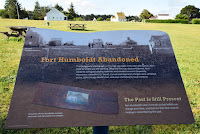Fort Humboldt State Historic Park is the site of the fort that was occupied from 1853 to 1870. The fort was built overlooking
We visited the park in early June and the weather was still very cool compared to the Central Valley of California where we had just come from. Being the "morning people" that we are, we arrived just before they opened the gate. Actually, it's a good thing we had Google Maps giving us the step-by-step directions, as the signage directing you to the site was not obvious. The gates opened at eight o'clock. The visitors center and the two buildings of the fort that remain were not scheduled to open until nine. We spent an hour and a half walking around the park, starting with a display of logging machinery that is co-located with the fort. The park is certainly well tended, but not well visited by all appearances. We pretty much had the park to ourselves with the exception of a local walking her dog and some high school kids on bicycles that I'm pretty sure were ditching the last day or two of school.
The buildings at the fort are the original hospital and a reconstructed surgeon's quarters. The hospital building has some displays on the history of the fort, but unfortunately they were not open during the time we were there. I guess that the park is staffed by volunteers and they were having a late morning. It was disappointing, but the main thing to see when you visit a historic site is actually the location and the lay of the land. The fort is on a bluff and today the city of Eureka has grown around the bay that the fort overlooks. It is obvious that the fort is defensible with a small number of soldiers (I believe that less than 50 were typically at the fort), and the view allows for easily spotting arriving ships.
Probably the best part of visiting Fort Humboldt State Historic Park is knowing that you are walking on the same ground as U.S. Grant, George Crook, and other noteworthy soldiers from the Civil War period. You also gain a glimpse into what their living conditions were while serving in what was then still a far off place, well removed from the civilization in the East that these soldiers were used to.
Next stop in this little "Grant Pilgrimage" I've got going on will be
a visit to Fort Vancouver, another frontier outpost where Grant served before his civilian hiatus from the army.







